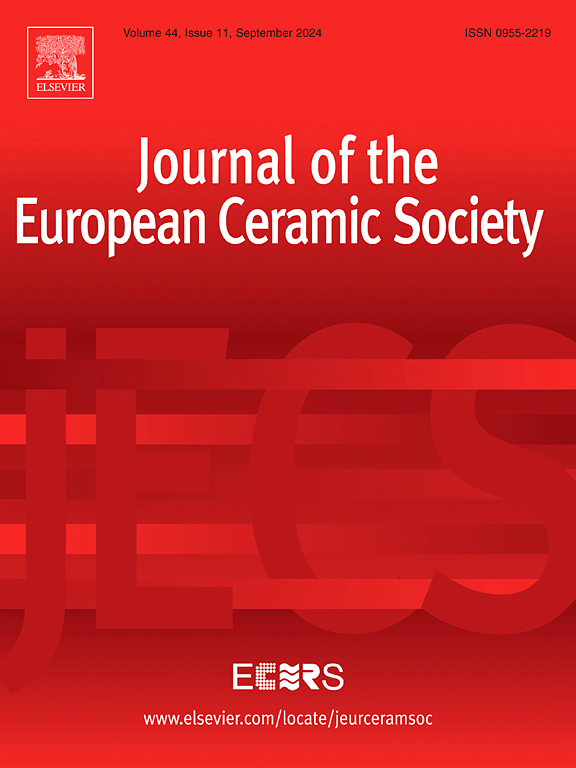Reactive spark plasma sintering of ultrahard wear-resistant boron carbide-SiC-TaB2 composites from B4C with TaSi2 aids
IF 5.8
2区 材料科学
Q1 MATERIALS SCIENCE, CERAMICS
Journal of The European Ceramic Society
Pub Date : 2025-06-13
DOI:10.1016/j.jeurceramsoc.2025.117626
引用次数: 0
Abstract
The fabrication of new ceramic composites by reactive spark plasma sintering (SPS) from B4C with 5–30 vol% TaSi2 aids was investigated, next evaluating some of their mechanical-tribological properties. First, it was found that, because a transient Si melt is formed, TaSi2 aids reduce significantly the SPS temperature of B4C (down to 1800°C for 5 vol% TaSi2 and 1550°C for 30 vol% TaSi2, temperatures at which pure B4C is unsinterable). Second, it was found that reactive SPS from B4C+TaSi2 results in novel B12(C,Si,B)3–SiC–TaB2 composites, with less B12(C,Si,B)3 and more SiC+TaB2 with increasing vol% TaSi2 aids. These composites are all very hard (≥27.5 GPa), some even superhard (∼32–33 GPa), and tougher than monolithic B4C. In particular, the composite reactively SPS-ed from B4C with 20 vol% TaSi2 shows the optimal balance between sinterability (SPS at 1650°C), hardness (∼32.1 GPa), and toughness (∼3.5 MPa·m1/2). And third, it was found in friction pairs with diamond and ZrO2 that the optimally SPS-ed composite is highly resistant to the unlubricated sliding wear, undergoing only mild to very mild abrasion with specific wear rates in the order of 10−6–10−8 mm3/(N⋅m). Finally, the performance of these novel composites was compared with that of monolithic B4C and composites reactively SPS-ed from B4C with other metal disilicides.
含TaSi2助剂的B4C超硬耐磨碳化硼- sic - tab2复合材料的反应放电烧结
研究了以B4C为原料,添加5-30 vol% TaSi2助剂制备新型陶瓷复合材料的反应放电等离子烧结(SPS)方法,并对其机械摩擦学性能进行了评价。首先,发现由于瞬态Si熔体的形成,TaSi2有助于显著降低B4C的SPS温度(5 vol% TaSi2降低到1800°C, 30 vol% TaSi2降低到1550°C,在此温度下纯B4C是不可烧结的)。其次,发现来自B4C+TaSi2的活性SPS产生了新的B12(C,Si,B)3 - SiC - TaB2复合材料,随着TaSi2助剂体积百分比的增加,B12(C,Si,B)3减少,SiC+TaB2增加。这些复合材料都非常硬(≥27.5 GPa),有些甚至是超硬(~ 32-33 GPa),比单片B4C更硬。特别是,含有20 vol% TaSi2的B4C反应性SPS-ed复合材料在烧结性能(SPS在1650℃)、硬度(~ 32.1 GPa)和韧性(~ 3.5 MPa·m1/2)之间表现出最佳平衡。第三,在金刚石和ZrO2摩擦副中发现,优化后的SPS-ed复合材料具有较强的抗无润滑滑动磨损能力,仅发生轻微至非常轻微的磨损,比磨损率为10−6 ~ 10−8 mm3/(N·m)。最后,将这些新型复合材料的性能与单片B4C和B4C与其他金属二硅化物反应的SPS-ed复合材料进行了比较。
本文章由计算机程序翻译,如有差异,请以英文原文为准。
求助全文
约1分钟内获得全文
求助全文
来源期刊

Journal of The European Ceramic Society
工程技术-材料科学:硅酸盐
CiteScore
10.70
自引率
12.30%
发文量
863
审稿时长
35 days
期刊介绍:
The Journal of the European Ceramic Society publishes the results of original research and reviews relating to ceramic materials. Papers of either an experimental or theoretical character will be welcomed on a fully international basis. The emphasis is on novel generic science concerning the relationships between processing, microstructure and properties of polycrystalline ceramics consolidated at high temperature. Papers may relate to any of the conventional categories of ceramic: structural, functional, traditional or composite. The central objective is to sustain a high standard of research quality by means of appropriate reviewing procedures.
 求助内容:
求助内容: 应助结果提醒方式:
应助结果提醒方式:


